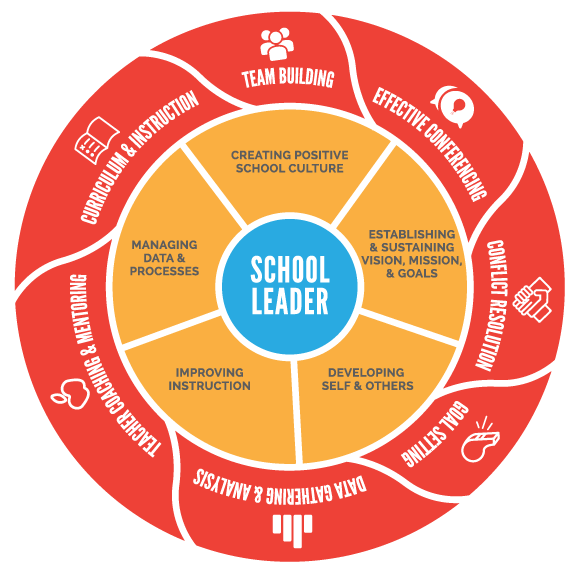5 Themes of AEL
The development of the AEL curriculum brought together education stakeholders from across Texas, representing universities, education service centers, educator preparation programs, and district leadership, to provide input for key concepts within the content and training design. The groups issued strong recommendations that AEL be organized in a manner that facilitated participants’ recognition of the connections and relationships between and among the seven strands, thus the emergence of the five conceptual themes:
Creating Positive School Culture
A positive school culture is essential to the overall success of the students on campus and the school as a whole. The culture of a campus is developed by all stakeholders, but the instructional leader is the one who guides the direction and speed at which the school culture takes effect. A school’s culture is the foundation for the school’s growth and achievement.
Establishing and Sustaining Vision, Mission, and Goals
School leaders bring leadership and collaboration to the establishment of a clear vision, mission, and goals for the campus to ensure clarity of roles and buy-in. Working strategically, they engage stakeholders in meaningful ways to ensure the vision and mission are sustained over time and goals are monitored, achieved, and revised.
Developing Self and Others
Development of oneself is a key responsibility to ensuring the success of a school leader. Working to develop others requires a variety of skills that leaders should always be strengthening and refining. The greatest impact on students comes from effective teachers in the classroom, so this should be the focus and goal for development of other staff on the campus.
Improving Instruction
As the demands of student assessment and student accountability measures increase, campus instructional leaders must develop teachers’ capacity to consistently deliver highly effective instruction.
Managing Data and Processes
Data gathering and analysis followed by team building and effective conferencing are vital components for a principal to lead a campus that is focused on continuous improvement.

7 Strands of AEL
The seven Advancing Educational Leadership (AEL) strands align to the principal standards established by the Texas Education Agency and as reflected in Texas Administrative Code. The strands are an articulation of what successful school leaders must know and be able to do:
Curriculum and Instruction—Principal Standard: 1(A)(i):
The principal must lead the entire campus in the areas of curriculum and instruction through their prioritization of curriculum and the C&I support structures across the campus. The leadership and support of campus-wide curriculum and instruction is done through monitoring of implementation, alignment, assessment, and student learning outcomes.
Data Gathering and Analysis—Principal Standard 1(A)(ii):
Successful school leaders use a wide variety of data to make decisions about school and classroom practices and provide curricular interventions for students.
Goal Setting—Principal Standard 2(A)(i) and 5(A)(i):
Principals must have the ability to articulate clear and compelling goals, a skill that fosters school success.
Effective Conferencing Skills—Principal Standard 2(A)(ii) :
Effective administrators have high-quality conference skills that allow them to positively coach and mentor their staff by planning conferences, engaging in reflective questioning, and providing appropriate feedback.
Conflict Resolution Skills—Principal Standard 3(A)(i): While conflict occurs on every campus, an administrator can effectively resolve conflict, leading to personal and professional growth in the parties involved in the conflict.
Team Building Skills—Principal Standard 5(A)(ii):
Highly effective principals build strong teams throughout their entire staff, empowering them to plan and problem solve, creating campus improvement and student success.
Teacher Coaching and Mentoring—Principal Standard 3(A)(ii):
Campus instructional leaders use coaching and mentoring to support the continuous development and growth of their staff and ensure greater student success in every classroom.